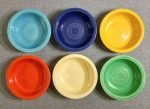
Original 6 Colors
The Fiestaware colors that are the most collectible (and thus fetch the highest price) are the 14 colors produced before 1973, when Fiesta temporarily went out of production. These discontinued Fiestaware colors can be divided into several categories: The Original Fiesta Colors The original colors are cobalt blue, light green, ivory, red, turquoise and yellow. These colors were introduced in 1936. Of these colors, the production periods are as follows:
- Cobalt Blue Fiestaware – 1936 to 1951
- Light Green Fiestaware – 1936 to 1951
- Ivory Fiestaware – 1936 to 1951
- Red Fiestaware – 1936 to 1944*; 1959 to 1972
- Turqouise Fiestaware – 1937-1969
- Yellow Fiestaware – 1936-1969
It”s interesting to note that, between 1944 and 1959, red Fiestaware was not in production. This is because during World War II, the U.S. government banned all use of uranium oxide, the substance that gives Pre-1944 Fiestaware it”s red color. That”s right – uranium oxide – the same material that is used to make “yellowcake” which can then be used to make atomic bombs! The government seized all of Homer Laughlin”s supply of uranium oxide, meaning no more red Fiesta unti lthe ban was lifted in 1959. We”ll discuss more about red Fiestaware in a later post.
The 1950s Fiesta Colors In the 1950s, the Fiestaware line was greatly expanded to include chartreuse, forest green, gray, rose and medium green. Of these colors, medium green is often the rarest color to find a piece of Fiestaware in. Medium green was in production between 1959 and 1969. Production Periods:
- Chartreuse Fiesta – 1951 to 1959
- Forest Green Fiesta – 1951 to 1969
- Gray Fiesta – 1951 to 1959
- Rose Fiesta – 1951 to 1959
- Medium Green Fiesta – 1959 to 1969
Ironstone, Amberstone and Casuals Antique gold, mango red and turf green were later added after 1969, when Fiestaware temporarily ceased production to make way for the Fiesta Ironstone, Casuals and Amberstone lines. So, while these items made after 1969 are certainly genuine Homer Laughlin China, they aren”t technically “Fiestaware.” These lines ran from:
- Antique Gold Fiesta – 1969 to 1972
- Mango Red Fiesta – 1970 to 1972
- Turf Green Fiesta – 1969 to 1972
A quick note about identifying colors – most places where you”ll find discount Fiestaware and discontinued Fiesta won”t identify them by their official Fiesta colors. Plus, it can be particularly difficult to tell the difference between medium green and light green in digital pictures or in poor lighting. To make matters more difficult, the Fiestaware may be discolored due to age or variations in production. So, the only real way to tell if a Fiestaware is collectible is to identify the imprint on the bottom. Stay tuned for a discussion on dating your Fiestaware by markings!
your blog says to use your link to ebay to purchase fiestaware…but can’t find the link…help! S.
Sorry about that. If a link isn’t working, please follow the link at the top of the page to the Fiestaware Reviews site and try those links. All the links should be working now. Unfortunately Ebay is always changing the way their links work.
I was wondering about the dinner set that cane in the box of ceral ? i have no markings on the bottom some one tld me that they were very old . can you please le tme know as i do have a chance to sell them and wanted to find out the price of what they would sell for.
thank u susan
How many rings are on the back of Harlequin plates verses Fiestaware?
How can I tell if something is Mango Red or Original REd?